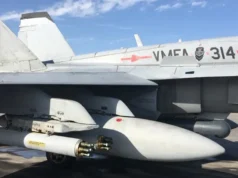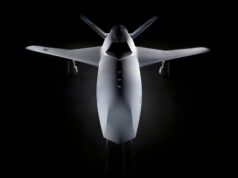Back in July, the Ministry of Defence has announced a comprehensive framework for missile defence research and development, titled Science and Technology Oriented Research and Development in Missile Defence (STORM).
The contract will manage the delivery of research covering all activities to counter ballistic missiles and advanced threats, including but not limited to simple non-separating threats, complex separating threats, Manoeuvring Re-Entry Vehicles (MaRVs), Multiple Independently Targetable Re-Entry Vehicles (MIRVs), Hypersonic Glide Vehicles (HGVs), Hypersonic Cruise Missiles (HCM), and hybrid threats.
The research required will cover analysis, experimentation, trials, and technology/system development across all pillars of missile defence:
- Counter-proliferation: Measures to minimise the spread of missile technology.
- Deterrence: Measures to discourage the use of missile threats.
- Counterforce: Actions to reduce the quantity of missiles and supporting equipment available to an aggressor during a conflict.
- Active defence: Strategies to detect, track, intercept, and disable or destroy missiles in flight.
- Passive defence: Measures to mitigate and recover from the effects of missile impacts.
The STORM framework, with an estimated budget of £110 million to £251 million, addresses a broad spectrum of missile defence activities.
According to the MoD, the contract will “manage delivery of research covering all activities to counter ballistic missiles and advanced threats including but not limited to simple non-separating threats, complex separating threats, Manoeuvring Re-Entry Vehicles (MaRVs) and Multiple Independently Targetable Re-Entry Vehicles (MIRVs), Hypersonic Glide Vehicles (HGVs), Hypersonic Cruise Missiles (HCM) and hybrid threats which share characteristics with BM, HGV and/or HCM.”
The MoD outlined the historical and ongoing challenges posed by ballistic missiles:
“Since the first V2 attack on London in 1944, ballistic missiles have posed a near constant threat to the UK, its overseas interests, and forces. Adversaries continue to invest in and proliferate increasingly advanced ballistic and manoeuvrable threat systems to challenge our freedom of action.”
The MoD specifies the pillars of missile defence research under the STORM framework as follows:
- “Counter-Proliferation: Measures to minimise the spread of missile technology.”
- “Deterrence: Measures to discourage the use of missile threats.”
- “Counterforce: Actions to reduce the quantity of missiles and supporting equipment available to an aggressor during a conflict.”
- “Active Defence: Strategies to detect, track, intercept, and disable or destroy missiles in flight.”
- “Passive Defence: Measures to mitigate and recover from the effects of missile impacts.”
The UK Missile Defence Centre (MDC), a unique government-industry partnership within the MoD Head Office, will spearhead the STORM framework, according to the previous notice. The MDC is responsible for all UK missile defence Research & Development (R&D) and provides support to decision-makers on all aspects of missile defence. The MDC was established to “provide a pipeline of funding to sustain SQEP (Suitably Qualified and Experienced Personnel) in relevant UK industry sectors.”
The MoD highlights the strategic importance of the STORM framework: “The Missile Defence R&D Category Strategy, approved in May 2023, recommended creation of a new route to market bringing together core research and technology maturation projects into a single contract, enhancing research outcomes and supply chain efficiency.”
The selected contractor will work closely with the MDC to “design and manage a contract pipeline to deliver the Missile Defence R&D category’s research requirements.” This includes large, multi-year research technology maturation projects, multinational and multi-supplier trials, and short-term rapid analysis. The coordination function is envisaged to be co-located with the Missile Defence Centre in Farnborough.
The notice further details that “the research required will cover analysis, experimentation, trials and technology/system development across all pillars of missile defence.”
The STORM framework is part of the 2020 MOD Science & Technology (S&T) Strategy, which aims to “sustain, exploit, and develop UK industrial and academic expertise to continue to develop next-generation and generation-after-next technologies applicable to Integrated Air and Missile Defence.”













What is the point in sky sabre if it can’t protect us from most air threats?
To protect us from the threats it is capable of protecting us from. Just because it’s an air defence platform doesn’t mean it can engage every aerial threat. 30mm naval guns can’t sink every ship out there, an SA80 won’t destroy a tank, etc. Still have applications.
It is horses for courses. Sky sabre is not designed to counter all missiles because it is not expected to counter all missiles.
You would not use Ballastic or hypersonic missiles in the battle field but you would expect to see rocket artillery, glide bombs etc but the battle field is very fluid
SkySaber is not made or operated with the intent of protecting us, it’s sole job is to protect the army. All we have protecting us is the ever strained belief in MAD and a couple of QRA Typhoons. The UK has always been terrible when it comes to national air defenses; we have never invested in bunkers for the general public unlike many of our European allies have for years, we have no long range, permanently placed or rapidly deployable GBAD systems in country (as many nations do or are starting to bring in over major population centers) and our existing QRA force is primarily designed to counter long-range bombers from a bygone era, not mass missile, drone or ballistic attacks from extreme ranges or multiple directions.
“always” and “never” aren’t the correct words to use. The UK fought and won the world’s first major defensive air battle in 1940 and lots of air raid shelters were built in many cities and towns across the UK from 1939 to at least 1943.
By the 1950s with the cold war being the primary focus it didn’t make sense to spend money at huge rates on these things. We were still spending some though. Including bunkers for councils in the 1970s and 80s.
We have been far too slow though to recognize the threat from Putin’s Russia and we do need to urgently spend to catch up and maintain or re-establish a deterrence. Otherwise we will find we are going into the third world war even more poorly prepared than we were for either the first or second world wars.
No arguments from me 👍
See my post above concern for east Enders and actions to build shelters only occurred after the appalling publicity of the event above and others that followed with fears over public unrest. If you read the true story of the underground being used as shelters it is related the people commandeered them despite the authorities attempts to prevent it. Only events like this pressured the real effort to build shelters… well for ordinary people rather than the toffs, elite and those deemed more worthy.
Civil servants, elite and politicians spent quite a lot of time in the deep Camden tube station complex where the wartime transport executive worked to keep the system working against all odds because it was renown for its excellent restaurant and food. Alright for some.
Indeed sounds familiar. The first air raid disaster in the war was when many hundreds of east end families were hosed in a school and not moved out to a safer plaice. The inevitable happened it was bombed and many were unnecessarily killed including many children. This was reported by Simon Calder father who as a journalist covered the event and had done his best to get the authorities to act. Sadly as per usual urgency with such citizens wasn’t deemed a priority.
My understanding is that Skysabre is a battlefield point defence system.
Intercepting Ballistic missiles or fast/hypersonic cruise missiles requires a much more sophisticated radar system, and bigger missiles with a longer range.
Every system cannot defend against every type of threat..a warhead from an intercontinental ballistic missile traveling at 15,000 miles an hour and at an altitude of 150 miles needs a multi stage orbital booster with exoatmospheric kill vehicle and a very powerful large aperture radar looking straight up ..a drone at 100 feet travelling at 100mph needs a totally different solution, including a look down radar, looking for small slow targets against ground clutter and a small mobile thing to intercept and kill it.
Just. Heck out the Israeli system, Iron Dome but a third of it covering different ranges and types of threat. The Polish system will be three different missiles one of which is using CAAM missiles as used in Sky Sabre. Even Patriot isn’t a single system in reality.
Systems already exist, just save time and money and buy what’s already been developed! This is all about bunging money to industry and not about defence! This is why we spend so much and have bugger all to show for it.
I suppose the issue is at what level…yes all the systems exist but be don’t have 100 billion pounds to defend against everything…nor the industry and technical capabilities nor are they all available on the open market.
If you really want a credible defence against intermediate and intercontinental ballistic missiles you need a space industry that’s capable of building and launching multi stage orbital rockets. The U.S. is not selling its GBI and GMD systems to anyone.
your correct if all they want is a defence against short and medium range ballistic missiles with non separating warheads or single separating warheads and cruise missiles…that’s off the shelf…with only a couple of options to be honest..buy American or buy.
But they have clearly stated capacities against MIRVs and that means ICBMs ( …which is not off the shelf or available.)..it seems the Uk government is seeing if the is a cost effective way to counter MIRVs launched by ICBMs…thats major..
The scale of a full on nuclear attack and MIRV is not realistically something which can be defended within our budget constraints. We have a defence against that already in Trident.
The primary risk factor which GBAD can realistically cover is from cruise missiles and conventionally armed ballistic missiles. I just can’t see the point in trying to reinvent the wheel with our track record of project delays and going over budget. It will be 2040 at best before we see anything result from this.
I would hope Lockhead and Airbus are only included for competitions sake and are not actually serious contenders.
It is bad enough contracting out the thinking part of military, it’s even worse when the thinking part takes orders from Washington or Brussels.
Lockheed makes perfect sense as they make the THAAD and are one of the primary contractors of AEGIS ashore- both seem to be the most logical solution for the UK if using off the shelf tech.
All these companies are on the framework and they will each have different areas they will be actively looking at. It will now be a simple process for the MOD to assign work to any of those companies. They might have a mini competion but I am not suspecting PWC (for example) are likely to be producing any hardware. They will probably be more interested in the other areas of the framework. This is a decent step forward.
UK also needs a fully integrated, multi-redundant, multi-layer missile/drone air defence software system that as as secure as can possibly be, to control all of this. I hope this is in place or rapidly under development by the UK?
Storm is very very interesting, it’s not really about getting some defence against a small number of cruise and short range ballistic missile defence for key targets..look at the scope it’s huge.
Independent multiple reentry vehicles are in international ballistic level threat..that they are looking at combating these is a profoundly significant paradigm shift ( it may be a total waste of cash..but it a profound shift).
Also look at the pillars..deterrence, counter force, active and passive defence ( civil defence structures)…that’s not about buying a missile defence system that’s about how you fight a peer war/ potential nuclear war in the modern age.
Why bother, we are not going to invest in anything.
Goodie. Another research project. How many is this for the currently broken armed forces some time in la la land.
I agree we are wasting bns on research projects. The best idea is to get off the shelf solutions rather than reinvent the wheel each time. Certainly because of its small size the UK has the advantage of requiring fewer defence ‘strongpoints’ Than say the USA.
If you want to defend the UK you need a layered defence incorporating the Royal Navy, USAF,among others.
Large new housing developments should have ‘shelter’ laws.
There is a need to start somewhere, because an attack from Russia may come sooner than we think. No panic Mr Mainwaring!
Bring back Volunteer Civil Defence, Royal Observer Corps and a Territorial Reserve (Home Guard) for starters.
Surely it would make sense to just acquire the SAMP/T system like the Italians and french, it’s proven and highly capable, we would then also have a common pool of missiles with the navy in that case too like CAMM.
The Aster missile, even the Block 1NT is a purely endoatmospheric weapon. It can intercept targets up to a published 80,000ft, similar to Patriot PAC3 MSE But it should be able to engage all thee threats listed in the terminal phase. When the threat reaches its engagement threshold. To cover the UK for example, you will need lots of dispersed units.
The issue is that with MIRVs especially, you need to take them out before the ICMB’s delivery platform launches the MIRVs. ASs instead on one target, you now could have anywhere up to individual 12 targets.
I believe a lot of the ask for STORM has come about, due to how well SM-3 and Arrow -3 did defending Israel from Iranian ballistic missiles, that delivered single re-entry vehicles (so far!). These two systems have shown what is now not only possible but how effective they have now become. It was long thought that defending against IBCM and intermediate range missile was a waste of time as at least half would get through. This is no longer the case!
Wonder what PriceWaterhouseCoopers are going to be offering ?
They have exceptional spreadsheet skills and a world renowned PowerPoint presentation department. As that’s all that will emerge from this project they are key.
They are really good at talking the talk as well AKA bullshiting
More millions for more studies which will go nowhere.
Either buy Sea Viper for the land or buy AEGIS Ashore.
I do think the UK does need an OTH radar system.
The MOD said that since 1944 ballistic missiles have posed a near constant threat, so erm why do we have zero defence against them?
I would say that only in the last 10 years has it been really possible to defend against ballistic missiles, but also ICBMs. 20 years previous to that point there was a 50/50 chance of intercepting a ballistic missile in its terminal phase. Prior to that the odds were nearly zero. Unless you used nukes for air defence.
Up until recently it was thought that missiles such as SM6 and THAAD would let a large number get through. As they had only been tested against single threats. The thought of intercepting a threat in orbit was even more questionable, as the SM3 trials were not overly convincing. However, when Iran attacked Israel with intermediate range ballistic missiles, this all changed.
Israel employed their Arrow 3 to intercept exoatmospheric threats along with the USN using the SM3.. Neither country has publicly stated on the success rate of their respected missiles. But along with using Arrow 2, SM6, SM2 and Patriot. Out of a claimed 110 missiles fired at Israel in April, only 3 were not intercepted. Which is an amazing success rate.
Today (Tues 01/10/2024) Iran launched 180 ballistic missiles at Israel for retaliation against the attacks on the Hezbollah leadership. They haven’t said how many were shot down. But media footage does show some hits on Israel. This may be due to Israel not being able to replenish their missiles used to defend against the April attacks. As interceptors are far more complex and costly than a ballistic missile used to attack a grid square.
The primary reason why the UK does not have an anti-ballistic missile defence, is because 1. MPs don’t believe there is a threat. 2. The cost of the system is huge. Until MPs feel threatened, we wont see a system being bought. Perhaps only having a limited system on our destroyers.
6th largest GDP in the world, FA to show for it.
Precisely Zilch.
So, the threat list: “1)simple non-separating threats, 2)complex separating threats, 3)Manoeuvring Re-Entry Vehicles (MaRVs) and 4)Multiple Independently Targetable Re-Entry Vehicles (MIRVs), 5)Hypersonic Glide Vehicles (HGVs), 6)Hypersonic Cruise Missiles (HCM) and 7)hybrid threats which share characteristics with BM, HGV and/or HCM.”
1 and 2 are categories that describe the rest, to my simple mind, rather than weapon types on their own.
3-5 seem to describe ballistic threats of various kinds, a number of them associated with ICBMs (i.e. nuclear weapons). I’m not sure that we’re in a place that we need a defence against them- from the perspective that likelihood of being on the receiving end and surviving vs price for the system makes it prohibitive.
5-7 describe (to me) the weapons we’re seeing being used in Ukraine and off the coast of Yemen, and are really the ones we should be thinking of having a credible defence for. But prioritise the deployed Army and Navy before the home islands; it’s far more likely they’ll be on thee receiving end of this stuff in Lithuania or (as has already happened) the Gulf than in the UK.
I suppose it’s worth reviewing the available options and what the future of threats and solutions looks like. But STORM seems to be a very expensive exercise for that, when solutions to 5-7 are immediately available in systems we already have or will have soon (Sea Viper, and likely CAMM-ER for some of those threats), and some of 3-5 soon (next generation of Aster missiles).
Please let common sense prevail and buy something off the shelf such as THAAD or AEGIS SM-3, our allies have already spent billions on the development of some potent options, don’t do the classic British defense spending option and spend it all again on developing a solution that already exists…
The Israelis would sell Arrow and Stunner missiles.
LM Aegis ashore, which could use SM3 and the vastly expensive SM6.
THAAD could be bought OTS
We could go with Aster and whatever France and Italy plan to replace it with.
Plenty of options.
What will all this science achieve given they have been offered 6 years to do it. At best it will come up with something akin to what Israel has in place today so why the wait. We have shipbourne systems such as that in the Type 45 which would be effective why not produce a land based variant or bite the bullet and buy Patriot or the 3 Israeli systems? But that would mean actually spending money and commiting to something far better to study it for a few years.
We could build say an extra 12 T31 Frigates with AAW to fill some of the Gaps for a ‘low cost’ option say 400m GDP each. That’s not a lot of money to also hugely strengthen the Navy.
The UK also has zero civil defence strategy to protect critical infrastructure. This goes hand in glove with missile defense. I think the official HMG position is ‘right chaps pretend this isn’t going to happen and do nothing’
Fast forward into the end of 2025:
Germany has its initial deployment of its layered architecture with IRIS T, Patriot and Arrow 3
Finland achieves some operational level of its David Sling
Israel has integrated its 100KW laser into its existing layered defense systems
Poland… still need to wait 2 more years for its Patriot batteries (there is a very long queue)
At what stage STORM will be?
The German approach is the correct one, develop one layer, buy the others